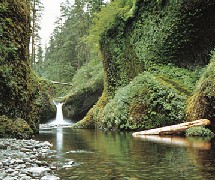 Already fraught with uncertainty and debate, forestry professionals and policy makers are going to have to rethink forest management and policy at US national forests and adapt quickly, according to recently released research conducted for the National Forest Restoration Collaborative.
Already fraught with uncertainty and debate, forestry professionals and policy makers are going to have to rethink forest management and policy at US national forests and adapt quickly, according to recently released research conducted for the National Forest Restoration Collaborative.
“Forests are not the solution to climate change, but they can make important contributions. They will be most effective in mitigating emissions in the near term (the next decade or two), which climate scientists have identified as a crucial period if we are to avoid potentially catastrophic changes in climate,” Defenders of Wildlife senior resource specialist Rob Brown writes in, “The Implications of Climate Change for Conservation, Restoration, and Management of National Forest Lands.”
Rethinking forest policy and management
Climate change is already underway and likely to take place more quickly than forestry policy makers and forest managers can adapt, at least if government policy and management continues to be spread out over a number of departments and agencies operating independently, according to Brown, who has worked for during the past 30 years has worked for the USDA Forest Service and the National Wildlife Federation.
Climate change is already altering conditions and forest life and will “inevitably cause further, more dramatic changes, both directly—through the direct responses of trees to altered temperatures and moisture—and indirectly—through shifting patterns of fire, insects and disease, which are generally expected to increase in extent and severity.
“Early actions to mitigate climate change will be more beneficial than later efforts,” writes Brown, whose report is based on a review of “key” scientific literature on climate change and forests.
Science, resource sharing in support of societal values
National forest policy and management is based on the values of a society and needs to be supported by scientific inquiry and research of the highest quality.
While fostering forests’ carbon storage capacity is and should be a central policy plank, it shouldn’t be the only one, Brown maintains. “The goal of carbon storage must be integrated with climate-adaptation strategies as well as traditional goals such as water, wildlife, recreation, and wood products,” he states.
One prominent and highly promoted option, short rotation forest management to produce long-lived wood products, has been shown to store less carbon than “simply letting the forest grow,” he points out. ”Factoring in losses of carbon from the conversion of mature and old growth forests, which is how virtually all managed forests begin, shows this option to be even less favorable.
“Substituting wood for more energy-intensive materials such as concrete might be beneficial, but the benefits of such substitution cannot be measured reliably, and should not be presumed without effective public policies to ensure that substitution occurs. “
Similarly, the net effect—positive or negative– of the growing forest management practice of thinning and fuels reduction in dry forests prone to fire in preparation for warmer and drier conditions as a result of climate change appears to be small and needs to be researched further.
While strategies for conserving biodiversity also need to be re-examined and modified in light of climate change, most of what needs to be done involves doing what policy makers and forest managers have know should be done for a long time: reducing habitat fragmentation, increasing populations of at-risk and controlling invasive species, according to Brown.


